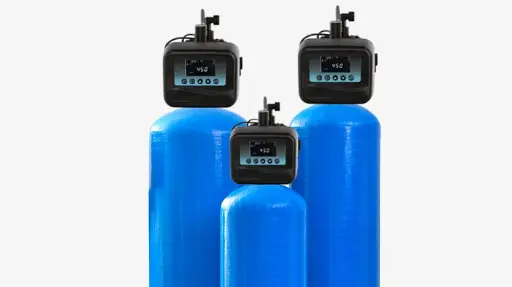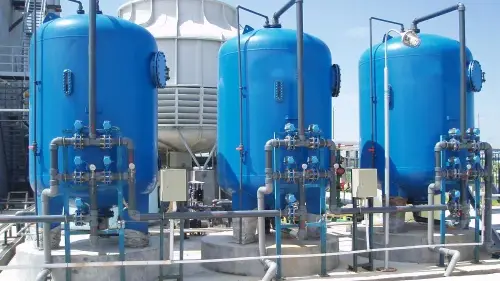
Activated Carbon Filter
Carbon filters are essential in purifying water by effectively eliminating various organic contaminants that can affect its quality. These impurities can lead to unpleasant tastes, odors, and colors, making the water less appealing and potentially unsafe for consumption. Utilizing carbon filtration ensures that the water meets safety standards while providing a refreshing drinking experience, enhancing its overall quality for everyday use.
Activated carbon filters are specialized devices designed to eliminate free chlorine, chloramines, and organic acids from water. They are commonly utilized in industrial water treatment systems, particularly in processes that involve water conditioning and membrane filtration, to safeguard membranes and ion exchangers from chlorine damage. These filters are made by heating natural materials like coal, wood, and coconut shells through processes that involve high temperatures, low oxygen, and steam. The carbon utilized in these treatment systems features pore sizes between 500 and 1000 nm and boasts a surface area of around 1000 square meters per gram.
Activated Carbon Filter Product Series
Check our product groups designed for your needs
Residental or Light Commercial
Activated carbon filter systems for resindental usage or light commercial low capacity requirements.

Industrial High Capacity Filter
High capacity activated carbon filters with externally manifolded system for industrial purposes.

Custom-Size Carbon Filters
Custom-designed activated carbon filtration systems for lab or industrial purposes.

Activated Carbon Filter Systems for Residental and Commercial Usage

FL Series Residental Carbon Filters
With a capacity range from 0.75 m³/h to 1.5 m³/h, this system is equipped with a Fleck valve and features fully automatic control for seamless operation and reliability.

RX Series Residental Carbon Filters
With a capacity range of 0.75 m³/h to 1.5 m³/h, this system features a Runxin valve with a digital control display, ensuring precise and efficient operation.

FL Series Light Commercial Carbon Filters
With capacities ranging from 2 m³/h to 10 m³/h, the FL series features a Fleck valve with automatic control, ensuring dependable and efficient performance for light commercial applications.

RX Series Light Commercial Carbon Filters
The RX series offers capacities from 2 m³/h to 10 m³/h and comes equipped with a Runxin valve featuring a digital control display for precise and reliable operation for commercial applications.

CL Series Light Commercial Carbon Filters
Featuring capacities between 2 m³/h and 10 m³/h, the CL series is equipped with a Clack valve, a U.S.-manufactured product with a digital control display for efficient and high-quality performance..
Activated Carbon Filter Systems for Industrial Usage

Industrial Carbon Filters with FRP Tanks
Our industrial externally manifolded carbon filters with FRP tanks offer a capacity range of 10 m³/h to 60 m³/h, providing durable and lightweight solutions for efficient water filtration.

Industrial Carbon Filters with Steel Tanks
Designed for high-capacity needs, our industrial carbon filters with steel tanks deliver robust performance, accommodating flow rates from 25 m³/h to 185 m³/h.
Custom-Design Systems For Your Needs
Discover tailored custom system solutions designed to meet your specific requirements. Enhance water quality and system performance with our customizable options today!

Phone
Address
Akçaburgaz, 3026. Sk No:28, 34522 Esenyurt/İstanbul TURKEY
Trusted references
Discover the trusted brands that rely on our carbon filters and explore all our references with a single click.
See our all references






How Does an Activated Carbon Filter Work?
Carbon is a substance that can have large surface areas due to its structure. 1 gram of carbon can have a surface area of approximately 500 to 1000 m2. Thanks to this feature, the contact area with water increases and allows water to be filtered at high capacity with small volumes. In some cases,
Carbon reacts with the free chlorine in the water passing through it, produces chloride and leaves some organic acids on the carbon surface. These compounds that bond with carbon are separated from the water and chlorine-free water is provided from the filter outlet.
Active carbon filters cannot be regenerated as in softening systems, but they need to be backwashed at certain periods, as in sand filters. In this way, both the solids accumulated on the surface are thrown out and the saturated surface is mixed, allowing the surfaces that have not yet come into contact with water to be exposed to water. This continues until the carbon in the filter is completely saturated. This period varies according to the usage characteristics, but it is between 12-18 months for filters used for chlorine removal. Activated carbon filters used for TOC removal must be changed every 6-12 months.
Chlorine and other oxidizing components are separated from water by an oxidation/reduction reaction. Chlorine oxidizes carbon in the reduction phase and forms hydrochloric acid as seen in the equation above.
C*: Oxidized carbon
The above reaction occurs instantaneously in the filter and as a result of the reaction, free chlorine drops to 0.05 ppm. The residual chlorine amount at this value is sufficient for reverse osmosis membranes.
Carbon Filter Operating Conditions
Although the water inlet requirements of activated carbon filters vary according to the design, the following conditions are required in standard filters.
- Turbidity < 5 NTU
- Free Chlorine < 10 ppm
- TOC < 5 ppm
Use of Activated Carbon Filters in Reverse Osmosis Systems
Activated carbon filters are also used as pretreatment components in reverse osmosis systems along with other filters. Since the free chlorine content in water is quite harmful to reverse osmosis membranes, this chlorine must be retained at the reverse osmosis inlet in order to protect the membranes. Activated carbon filters retain this chlorine and ensure that chlorine-free water is supplied to the osmosis system.
Carbon filters are not designed to retain suspended solids and bacteria. For this reason, when used at the osmosis inlet, a multimedia sand filter must be added for suspended solids and bacteria. In addition, carbon filters cannot retain bacteria and provide a very good environment in terms of nutrients for bacteria to reproduce. Bacteria formed in carbon filter systems without a sand filter in front of them can easily reach the RO system and cause contamination there. For this reason, in sensitive processes, activated carbon filters must be periodically sanitized with hot water or steam.